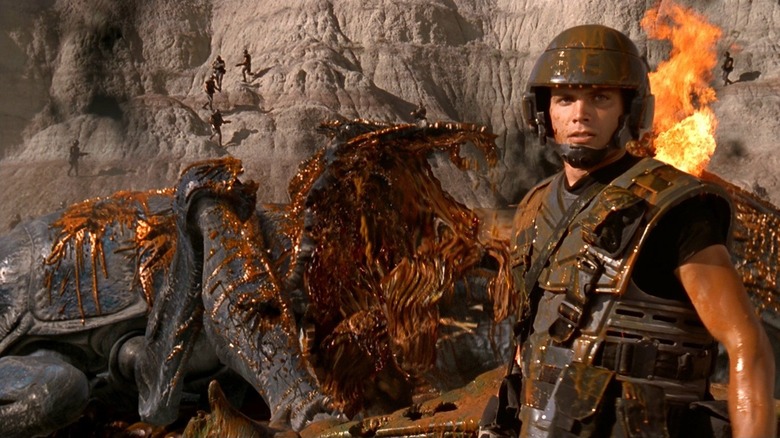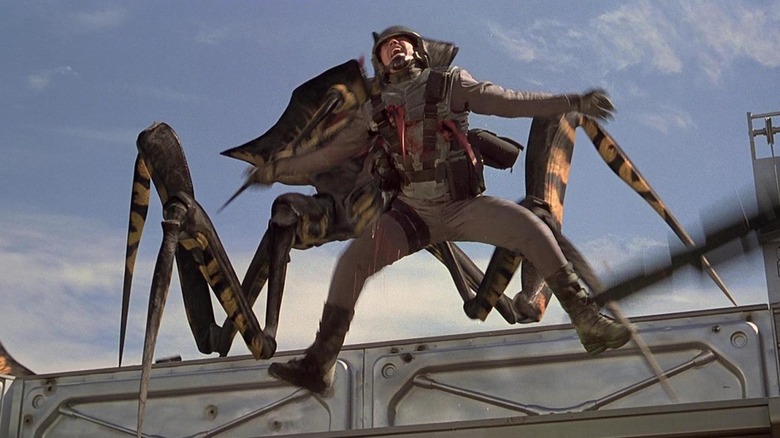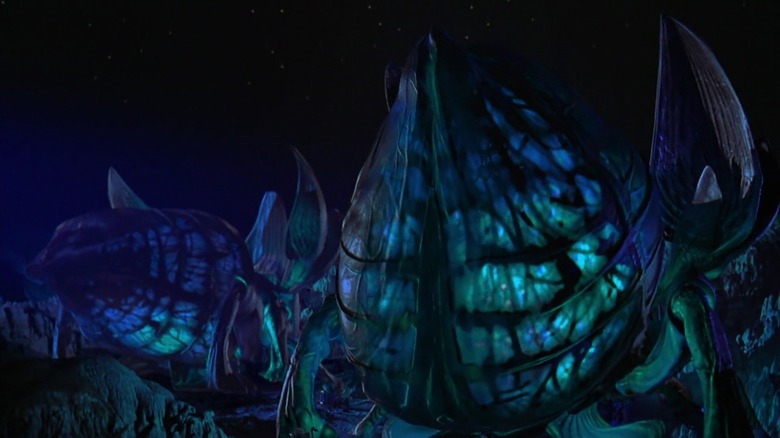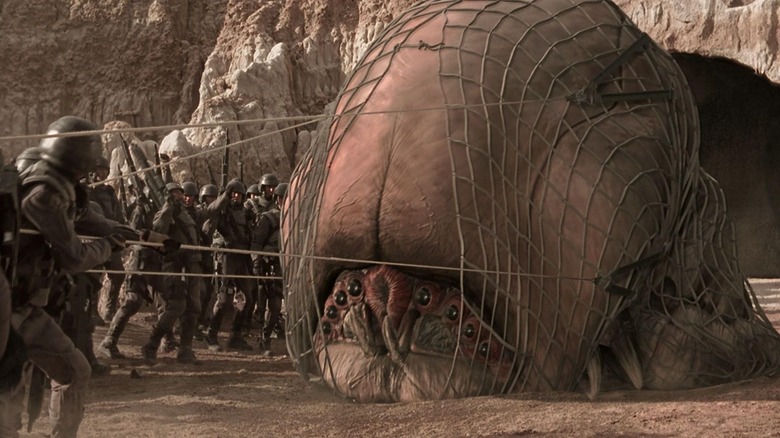The Different Types Of Sci-Fi Bugs In Starship Troopers, Explained
Paul Verhoeven's 1997 sci-fi war film "Starship Troopers," based on the 1959 novel by Robert A. Heinlein, is a vicious satire that lampoons the aggressive, unthinking language used to bolster unjust, fascistic wars. The main characters are all young, attractive, empty-headed grunts inducted into a meaningless 24th-century intergalactic war with a distant species of giant intelligent arachnids.
The most notable feature of Verhoeven's film, however, is the propaganda videos that periodically fill the screen. Clear-voiced, boldly preachy short films announce to the audience that the war needs to be fought and that the government needs as many able-bodied youths as it can wrangle to feed them into the soul-hollowing combat machine. "The only good bug is a dead bug," people growl. Anti-bug sentiment is high.
Also, the film is a comedy. Screenwriter Edward Neumeier ("RoboCop") strikes a broadly cynical tone, playfully dissecting the American war machine and the politicians who spoke of war as a grand, noble endeavor. The satire, sadly, didn't strike hard during the Bill Clinton administration — a time when no major wars were raging — so it took several years for audiences to latch onto the film's themes. It might have been received better five years later.
The bugs were meant to represent a fascist's view of any and all perceived enemies. Fascist leaders love to refer to their foes as vermin, dehumanizing them enough for their armies to seek extermination. The Klendathu Arachnids, however, capably defend themselves, seeing as they are armed with organic space projectiles, armored plating, and massive claws.
In 2020, American Cinematographer Magazine talked to Craig Hayes and Phil Tippett, the designers of the "Starship Troopers" bugs, and he handily pointed out that there were seven distinct types of Arachnids in the movie, and they spoke briefly about the designs for each one.
Starship Troopers bugs explained: Warriors and Hoppers
Viewers of "Starship Troopers" might notice that the stick-like clawed Arachnids seen throughout the movie sport camouflage-like patterns. This was based on a mandate from Paul Verhoeven that his film is a war picture and that military imagery should be employed frequently. The patterned Arachnides were nicknamed Warriors, and Tippett described them as the movie's "ground troops." Indeed, the various bugs, while apparently different species, were designed to evoke different branches of the military. Tippet explained:
"The Warriors are the ground-based troops, the Plasma bugs are the heavy artillery, the Hoppers are the air force, and the Tankers are like flame-throwing tanks. Craig tried to create some logical consistency within the bug community. For example, the Hoppers are genetically mutated Warrior bugs: they just have legs in different places and differently elongated limbs. In the same way, the Plasma bugs are genetically altered Tankers ... they're a lot bigger and look significantly different, but there are a lot of similar design attributes."
Tippett also noted that there was a cinematic approach to creating monsters, specifically that he didn't want them to be fully seen and understood right away. The "faces" of the Warrior Arachnids are difficult to determine at a glance, as their mandibles look like a pair of scissors and their eyes are not visible. Everything's pointy. Tippett said this inscrutability was intentional:
"We wanted to achieve a balance with these alien adversaries. We didn't want you to take it all in or understand what they were the first time you saw them. Instead, we wanted their appearance to manifest itself over the course of 50 shots."
One has to watch several battle scenes in "Starship Troopers" to understand just what the various Warriors and Hoppers looked like.
Starship Troopers bugs explained: Plasma bugs and Tanker bugs
During the first major bug battle in "Starship Troopers," the human soldiers face off against massive stinkbug-looking creatures who can excrete explosive meteors from their Malpighian tubule systems. The meteors can knock starships out of orbit, and even soar through space all the way to Earth. That's some good aim. Hayes described them thus:
"The Plasma bugs are bulbous and greenish-blue colored with yellow stripes on their thoraxes. They're 85 feet tall and based on a cross between stinkbugs and fireflies. Since their butts are transparent, you can see some kind of reaction happening inside. There are only three shots of the Plasma bugs, which are seen in the Klendathu battle sequence: they move into position, take aim like pieces of artillery, and then fire."
The Plasma bugs are different from the similar-looking Tanker bugs, which are smaller, can burrow quickly through the ground, and can spray a kind of biological napalm from their foreheads. This was clearly inspired by the bombardier beetle that uses body-produced chemical explosions to scare off predators. About the Tankers, Hayes had the following to add:
"They're more like half-track tanks. They have multiple legs — a big set up front, and then a row of six small ones. They're mobile plasma sprayers, like flame-throwers, who shoot plasma like napalm from a nozzle between their eyes; the plasma is ignited by little spark generators dangling in front."
Hayes had worked with Verhoeven before — he designed the car-like ED-209 in "RoboCop" — so he recalls sitting with the director and sketching out a "hierarchy" of Arachnids, incorporating seven distinct species. That said, there was a conscious effort to make the bugs recognizably buglike; the Arachnids weren't meant to be too alien. The Tankers, Hayes said, were meant to evoke rhinoceros beetles.
Starship Troopers bugs explained: The Brain Bug and its Chariot Bugs
Late in "Starship Troopers," characters begin talking about a distant, semi-mythical Brain Bug that can siphon intelligence from human prisoners and psychically transmit it to the bug Warriors. The humans' goal will eventually be to capture and incapacitate the Brain Bug. When they find it, it's a large blobby monstrosity that can indeed extend a goopy spine from its anus-like mouth, stab a human in the head, and physically suck out their brain to gain their knowledge. The humans do indeed capture it and ... well, the humans aren't kind to it.
Tippett noted that the Brain Bug was meant to evoke certain of H.P. Lovecraft's Elder Gods. In his words:
"The Brain Bug is a pulpy, horrible creature that Paul always thought of as a Godking, Cthulhu-type thing. He does the nasty job of sucking people's brains out, so there are some human sacrifices happening."
Hayes elucidated, saying:
"Paul wanted it to look like a queen termite [...] He's into biology, so the Brain Bug looks a bit like a pus sack with flesh-colored, undulating sides that resemble a big intestine. Then there are the Chariot Bugs, the Brain Bug's entourage, which are 4-foot-long, cockroach-like things that band together to form a moving carpet which supports him. They're like comic relief."
The Chariot Bugs play a very small role in "Starship Troopers," adding only an air of insectoid mysticism to the entrance of the Brain Bug.
Tippett, it should be noted, had a fear of bugs going into the project. There were 250 effects shots in "Starship Troopers," and Tippett had to face his fears every day of production. It didn't cure him. "[I]nsects always gave me the creeps," he said. "Making this film was no catharsis."



